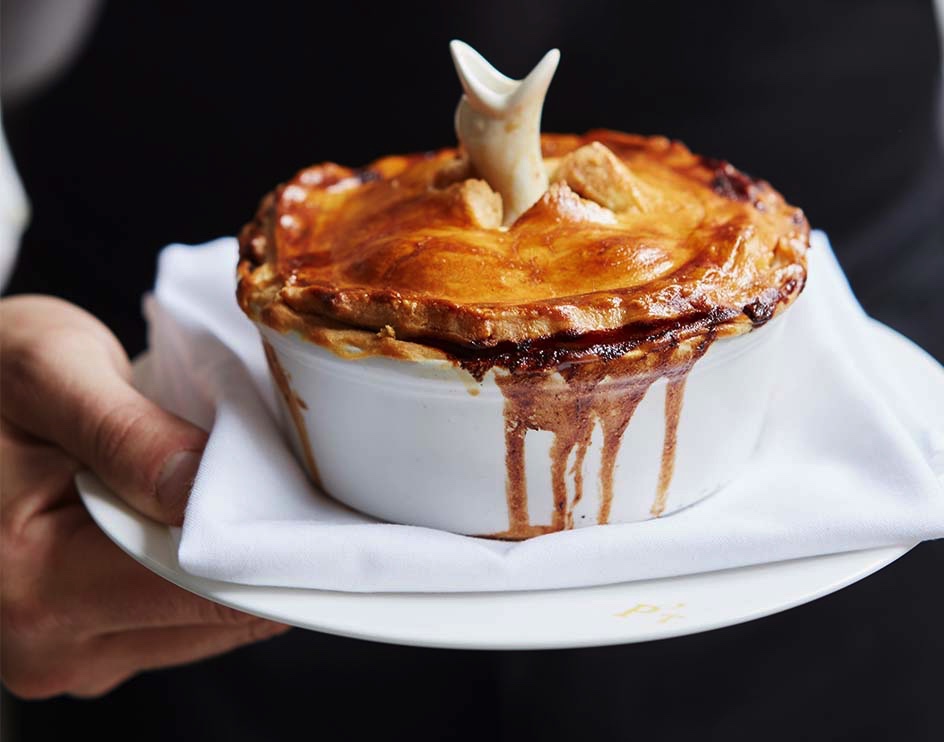Swan pie or a chicken tikka masala pie, anyone? Pies have a noble British history, and in and around Cambridge we celebrate a well-made one. Gilded swan and peacock pies are in an extravagant baroque banquet display at the Feast and Fast food and art exhibition at The Fitzwilliam Museum until the end of April. These are pies to marvel at, but certainly not nibble, faithfully recreated by Ivan Day, renowned food historian.
However, if you would rather eat a pie for British Pie Week, then how about the Hobson’s choice pies, crafted in the kitchens of Parker’s Tavern at the University Arms hotel? “We wanted a pie that could change daily and use local, seasonal ingredients,” explains chef director Tristan Welch. “They change, so our pie changes. Hobson is a famous figure in Cambridge and we wanted a Cambridge quirk. Apparently, the history of the term ‘Hobson’s choice’ is that he had a stable and used to rent horses. The strongest horses were rented out most frequently and became the most tired. So he decided to have a ‘get what you are given’ basis – the person hiring the horse would never get an option to choose. The same for our pies!”
One of Tristan’s favourites is the locally inspired Huntingdon fidget pie. “Our twist on the historically traditional harvest workers’ dish of apples and bacon cooked under a star-vented pastry lid is to take bacon, add a sausage-meat mix and roasted apples, then bake it as a raised hot-water crust pie, with an apple glaze,” he says.
Tristan’s guilty pleasure is combining chicken tikka masala (which originated in Glasgow, allegedly) and pie. Two British classics for the price of one! They have this Hobson’s choice on the menu at least once, sometimes twice, a week.
But what truly makes a pie, a pie? The standard definition is a mixture of sweet or savoury ingredients encased and baked in pastry. Many say that a pie has to have a base and a top, or have a lid and be baked in a pie dish. If it’s just a base, it would be called a tart, but is a ramekin dish with a pastry lid part balanced on top a pie?
Perhaps history can help. The earliest recorded British pie recipes date back to the 14th century, which brought large, flat, rectangular pies referred to as pasties. The hard rye pastry casing for the often highly decorated pasties would have a cavity made in the top to spoon out the contents. Typical fillings included venison, chicken or, by the 17th century, the fashionably new olives and sweet potatoes.
Pie records talk of pies made in the shape of hedgehogs
Pie records also talk of the taller free-standing pies made for Norman nobles in the shape of hedgehogs or porcupines. In the Tudor period, raised hot-water crust pastry pies were shaped as castles or contained live black birds that flew out to scare the diners at feasts.
Early pies were also called coffins – meaning containers – with small, individual pies called chewits and raised by hand, round a fist or wooden mould. The fillings of pork, onion, chicken and spices or, for fish days, haddock, cod, cream and herbs sound most enticing.
The pie as a container was very practical, as well as delicious. Large savoury pies, often made with a hard, rye-based pastry, once cooked, could keep airtight in a cool larder for weeks or even months. After cooking, the gravy was poured away, then clarified butter added through the top hole to create an airtight seal. They could later be reheated, fat poured off, and a fresh, hot gravy or ale-spiced and egg-thickened broth added back through the hole in the top crust. According to Ivan Day: “The wealthy were all for ostentatious display. A giant Christmas pie sent to King George III had over a hundred bird varieties – including 29 yellowhammers, 15 sparrows and a few chaffinches – all sadly dead. Such pies were emblems of gluttony and excess.”
More palatable Christmas pies of a fowl, a goose and a turkey were frequently sent as gifts. Letters of a 16th-century 14-year-old Magdalen College student from (sadly) Oxford, not Cambridge, show he regularly received pies of turkey, kid and preserved damsons from his mother.
By the 16th century, the use of the flakily layered puff pastry for sweet or savoury pies and hot-water crust pastry for small pork pies or raised game pies were favourites. By the early 18th century, short or shortcrust pastry was in use for fruit pies and pasties.
All the above involved the use of some form of pastry, but the non-pastry based fish pie and shepherd’s pie were introduced in the 19th century. This means that it may not be possible for us to have a fixed definition of a pie – but we think we know one when we see one.
So, to make up your mind about the question of what is a true pie, dine locally. The Architect on Castle Street has a dedicated traditional pie and mash bar and local favourites the Pint Shop, the Old Ticket Office and the Cambridge Brew House all take pride in a good pie.
And here’s to hoping that no one is going to revive the local Cambridgeshire delicacy of rook pie!

